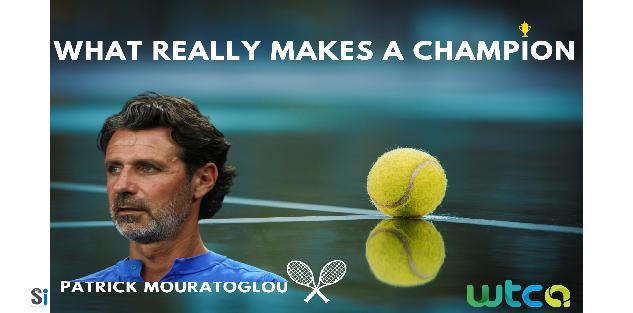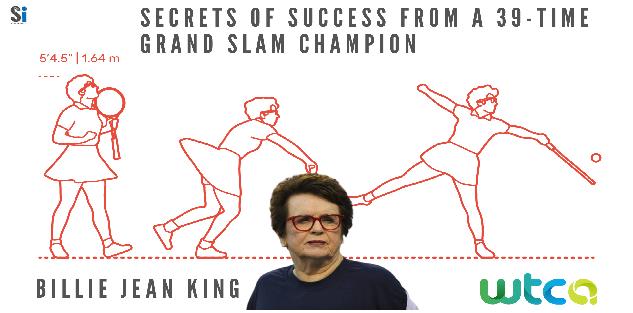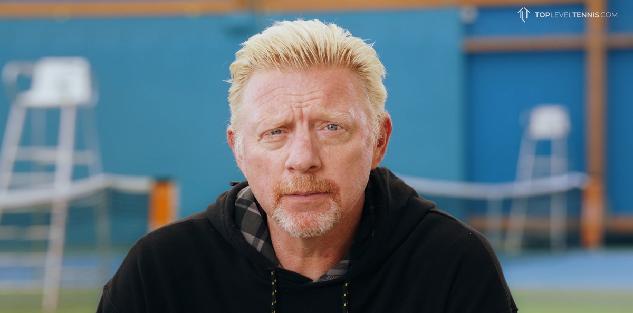Featured courses
- Four Tips to Turn Your Tennis Forehand Into a Weapon by Grant Young
- Tennis Legend Billie Jean King’s 4 Responsibilities as a Player by Grant Young
- Two Top Priorities For Success in Doubles Tennis by Grant Young
- Three of Tennis Whiz Lisa Dodson’s Tips to Improve Serves by Grant Young
- Three Elite Tennis Ball Machine Drills by Grant Young
- Three Keys For Correcting Tennis Serving Mechanics by Grant Young
- Five Tactical Tips to Win More Tennis Matches by Grant Young
- 4 Lessons Patrick Mouratoglou Learned From Coaching Serena Williams by Grant Young
- Four Effective Backhand Tennis Drills by Grant Young
- Two of Legendary Tennis Coach Paul Annacone’s Crucial Player Development Tips by Grant Young
- A Step-By-Step Guide To Mastering The Serve by Krsto Arsenijevic
- How to Dominate the Clay Court in Tennis by Krsto Arsenijevic
- 10 Essential Tennis Drills Every Coach Should Know by Brandon Ogle
- 8 Pre-Game Exercises to Prime Your Tennis Team for Competition by Neil Brown
- 7 Proven Tips To Develop Your Net Game in Tennis by Krsto Arsenijevic
- 10 Essential Tennis Drills Every Coach Should Know by Krsto Arsenijevic
- Developing Players - Two-handed backhand by Ramon Osa
- 6 Simple Warm-up Exercises For Tennis Players by Krsto Arsenijevic
- How to Beat a Serve-and-Volley Player by Krsto Arsenijevic
- How To Build Your Kinetic Chain Like Djokovic by Aiden Lefebvre
- How to neutralize a lefty in Tennis by Aiden Lefebvre
- 5 Tips To Improve Your Tennis Game Today by Krsto Arsenijevic
- Everything You Need to Know Before Buying New Tennis Shoes by Brandon Ogle
- Amp up your tennis practice with situational play by Neil Brown
- Tennis Equipment List by Brandon Ogle
- How to Master The One-handed Backhand in Tennis by Krsto Arsenijevic
- Modern High School Tennis Coaching Obstacles by Neil Brown
- Increase Your Tennis Fitness Level With 3 Easy Drills by Krsto Arsenijevic
- How to Successfully Hit a Two-Handed Backhand by Brandon Ogle
- How to Become a Grass Court Specialist in Tennis by Brandon Ogle
- How to Dominate the Hard-Court like Serena Williams by Brandon Ogle
- Hit a Drop Shot to Keep Your Opponent Off-Balance by Brandon Ogle
- New Tennis Injury Findings Linked to Neutral & Closed Stances by Oscar Wegner
- CHATTING WITH TENNIS PRO BRUCE CONNORS by Brandon
- How to Become a Mentally Strong Tennis Player by Brandon Ogle
- How to Win the Game of Angles by Hitting Cross-Court Shots by Eric Mahnke

How to Successfully Hit a Two-Handed Backhand
- By Brandon Ogle
University of Georgia tennis player, Lauren Herring, referenced the difference between forehands and backhands when she said, “Most tennis players have a bomb for a forehand and are weak in their backhand.” However, in order to be an all-around player, you must be able to hit a reliable backhand. Otherwise, opponents will consistently attack this and force you into errors. In this article, I’ll break down the process towards developing a two-handed backhand.
One-Hand or Two-Hand?and?
In tennis, you have the luxury of being able to choose between a one-handed or two-handed backhand. While one isn’t necessarily more dominant than the other, each are designed to fit different types of players. If you are a younger player, it would be most wise to utilize the two-handed shot. This doesn’t require nearly as much forearm strength as the one-hand and is an easier shot to hit. From personal experience, I find that the two-handed approach allows for a more stable racket, as well as the ability to generate added power from your body. Despite these numerous advantages, some players enjoy utilizing the one-hand shot because of their style of play. If you’ve got the power in your forearms to generate pace and enjoy making flashier plays, then the one-hand will be a better fit. With this said, for all beginners and most players in general, I recommend the two-hand for its ease.
Advantagesages
I touched on the advantages of a two-handed backhand briefly in the previous section, but will elaborate further here. One of the primary advantages is the stability it provides. By having two hands carry out the shot, you’ll be able to hit the stroke appropriately every time. You won’t have any unneeded arm movements that the one-hand tends to produce. Another advantage is the fact that it doesn’t require a huge backswing to produce pace on the ball. A short and quick backswing allows you more time to get into position to hit the shot. A final glaring benefit is the diminished injury potential to shoulders and wrists. Since you have two hands on the racket, the impact of the ball is distributed between the two, thus putting less stress on your body. Likewise, with the utilization of two hands, more power can be generated.
Disadvantagesages
As with any shot, there are some disadvantages you need to be aware of. When an opponent hits a strong shot that you have to run for, it can be tough to hit a two-hander while moving. However, it is possible to complete this shot with a one-hand hit. Additionally, balls that are lower tend to be tougher to get to since the two-hander is designed for the point of contact to be around your chest. The last primary disadvantage is the decrease in reflex shots you’ll be able to hit. It is typically tougher to hit a quick volley with both hands on the racket. For the majority of players, these disadvantages aren’t a huge loss. However, with experienced players, they can affect their style of play.
Shoulder TurnTurn
A two-handed backhand is greatly impacted by the severity and power generated from the shoulder turn. The turn of the shoulders is one of the critical factors that offset a shorter backswing. The shoulder turn is a tricky subject because if you get too much, you’ll put yourself in an awkward position, but too little will prevent the ball from having much speed. You want to position yourself in a set-up where you’ll be looking over your dominant shoulder to get a glimpse of the incoming ball. At this point, the majority of your weight should be on your back foot before transferring this to your front foot upon contact. Remember weight distribution and placement of the dominant shoulder.
Stay With the ShotShot
One of the worst mistakes you can make with a two-handed backhand is pulling off your shot early. After the point of contact, you should continue your momentum forward and extend your arms. At the end of your swing, elbows should be high. Also, rather than looking over your dominant shoulder like discussed earlier, you will now be looking over the non-dominant shoulder. Finish this entire process before worrying about transitioning into the next shot. Failure to fully finish will lead to diminished power and ultimately a waste of the entire coil that you started with.
Best Two-Handed Backhands in the GameGame
If you’re looking to adopt the two-handed backhand into your regular routine, there are plenty of players to analyze and see what they do to make theirs so dominant. Here are a few:
Novak Djokovic – Obviously, it’s easy to put Novak on any list as he is simply one of the best of all-time, but that doesn’t mean we can’t praise his tremendous backhand. Djokovic consistently takes advantage of his strong backhand in defensive situations, as well as hitting it down the line. The variety with which he uses it is something that sets it apart from the rest.
Andy Murray – The second two-handed backhand that I’ll suggest is one of Novak’s top competitors, Andy Murray. The British sensation routinely has displayed the ability to hit his with incredible speed. However, one area where he’s actually superior to Novak is with the slice, so check that out!
For a visual representation, I’ve included a video that breaks down the two-handed backhand from the perspective of tennis pro Gilad Bloom. This will allow you to see how he generates pace, as well as connecting firmly on the ball during the entire swing.
Stabilitylity
The best word I can use to describe a two-handed backhand is stability. This doesn’t mean you can’t play offensive tennis with it, but rather it provides ease throughout the swing process and is simply an easier shot to hit. It is generally a safer shot to hit than the one-handed backhand as well. This is possibly why we’re seeing more and more professional and recreational players abandon the one-handed approach for a more stable two-handed approach. As with any shot, make sure you work on it frequently in practice to the point that it becomes second nature.



